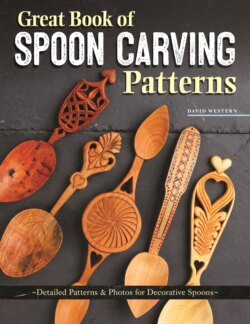Читать книгу Notes from a Swedish Kitchen - David Western - Страница 8
На сайте Литреса книга снята с продажи.
ОглавлениеParts of a Spoon
HANDLES
The handle is the most noticeable part of a romantic spoon. It is the busy area where the romantic symbolism occurs and where the woodcarving artistry is on full display. Although modern spoons have become extremely complex and artistic, traditional romantic spoons relied on a much more limited design palette. That doesn’t mean they were any less exuberant and passionate, though, and the craftsmen from each of the regions and countries highlighted in this book developed many unique and creative ways of decorating their spoons.
Detail of an exquisitely carved antique Welsh lovespoon.
STEMS
The stem area is found between the handle and the bowl and is an area outside of the bowl where carving was frequently undertaken on all faces and sides. Unlike today’s typical souvenir lovespoons that are uniformly machined from flat timber, almost all antique romantic spoons employed curved stems to add dynamism and technical virtuosity to the designs.
A deeply sweeping stem adds tremendous visual drama to the spoon by enabling the spoon to cast a shadow when hung on the wall and helping the spoon to feel more comfortable when held in the hand.
As it is frequently the weakest section of the spoon, the timber in this section is often left deeper than it is wide. This gives the stem an elegant appearance when viewed from the front, but allows it to maintain maximum strength and support against breakage.
BOWLS
The bowl was generally left unadorned on historical romantic spoons. However, that doesn’t mean that it wasn’t carefully and beautifully carved. Even on the crudest of antique spoons, an inordinate amount of time seems to have been spent ensuring the bowl was sleek and fair. Unlike modern souvenir spoons, the bowls on historical spoons were always elegant and refined with slender, delicate bowl walls and crisp, thin lips.
Historical spoon bowls appear light and dignified and offer a beautiful and serene counterpoint to the frequently busy handle designs. A spoon bowl is often tilted from its tip back toward the junction with the stem. This gives the spoon more visual vitality and is a clear indication to anyone viewing the spoon that the carver possessed both great skill and tremendous patience.
The sweep of the stem adds elegance and grace to a spoon’s design.
The bowl is the unsung part of the romantic spoon’s magic and is frequently overlooked or mishandled by modern carvers. A poorly carved bowl can completely undercut any hard work that has gone into the handle and stem and leave a spoon looking amateurish and unfinished. Carving a balanced and elegant bowl is perhaps the best way to create a romantic spoon that is memorable and worthwhile!
A well-carved bowl is key to the success of a spoon’s design.
Save for some occasional arching, the back face of antique romantic spoon handles was rarely decorated.
BACK SIDES
Traditionally, most romantic spoons were designed to be viewed from the front; they were commonly displayed hung on a wall or contained in a spoon rack. Although many carvers in the modern era like to finish both sides of the spoon’s handle, in the old days they were most frequently left completely unadorned and unfinished. In many cases, the back surface was only crudely carved and the edges were not rounded over in any way.
Occasionally, by tapering from the center line toward the outer edges, carvers would coarsely shape the back to create an illusion of elegance and thinness when the spoon was viewed from the side. This technique enabled the carver to retain a good deal of robust structural integrity while giving the visual appearance of delicacy.
On many modern spoons, the backs are periodically used as a place to engrave names, dates, or romantic quotations, but this was extremely uncommon on historical examples. Most of the spoons in this volume feature little to no carving on their backs.
This close-up shows the gentle arch shaping of the handle’s back surface. The top face of the spoon is flat; the bottom face of the spoon bows slightly outward from center, as you can see.
